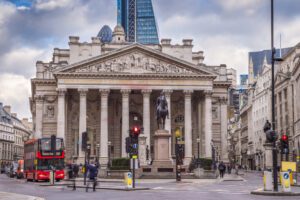
The Bank of England has held interest rates at 5.25% in a decision that saw its rate-setting body split three ways.
The Bank admitted it had discussed cutting borrowing costs, with inflation – which measures the pace of price rises – set to fall quickly this year.
Bank chief Andrew Bailey said it would wait for firm evidence that inflation was under control before it cuts rates.
But for the first time since the 2020 Covid pandemic, one Bank policy maker voted for an immediate cut.
However, while Swati Dhingra voted to cut rates to 5%, two members of the monetary policy committee (MPC) backed an increase to 5.5%. The remaining six members voted to keep rates unchanged.
It is the first time there has been a three-way split on whether rates should rise or fall since the 2008 financial crisis.
The Bank has been raising rates steadily over the past couple of years to try to reduce inflation, with the last rate rise coming in August last year.
Higher interest rates cool inflation by making borrowing more expensive, discouraging people and businesses from taking on debt to fund spending.
Inflation has fallen sharply from a 40-year peak in October 2022 and currently stands at 4%.
The Bank is charged with keeping price growth at, or close to, a target of 2%.
It said in its latest inflation report that the figure would fall back to that target between April and June this year – quicker than it had previously expected.
“We have had good news on inflation over the past few months,” Mr Bailey said.
But while the Bank is now suggesting that rates have peaked, the governor signalled that any cut in interest rates may still be some months away.
“We need to see more evidence that inflation is set to fall all the way to the 2% target, and stay there, before we can lower interest rates,” he said.
The Bank is expecting a slight rebound in inflation over the summer, and at the Bank’s news conference Mr Bailey said this was “not an acceptable state of affairs”. This suggests that any rate cut may not come as quickly as many expect.
There is concern among some economists that the fall in the inflation rate towards the Bank’s target is “artificial”, due to the cut in the energy price cap, and that inflation will rebound somewhat over the summer as global energy prices have picked up.
In addition, growth in pay remains strong, with the Bank’s survey of hundreds of companies pointing to a 5.4% rise in wage settlements this year.
Dr Dhingra, the economist who voted for a cut, pointed to risks from geopolitics, and the fact it takes a long time for rate decisions to affect the economy.
The Bank’s new forecasts indicate that keeping rates at their current level could push a barely growing economy into an outright recession.
Paul Dales, chief UK economist at Capital Economics, said that the Bank “sent some soft signals that the next [interest rate] move will be a cut, but it pushed back more strongly against the idea that rates will be cut soon or far”.
However, Mr Dales said he expected a faster fall in inflation and predicted the Bank would “change its tune in the coming months”.
“A rate cut in June is still possible and we think rates will end 2025 at 3%,” he added.
Yael Selfin, chief economist at KPMG UK, said she thought the Bank would be wary of keeping rates too high for too long, “particularly with the impact of previous rate hikes yet to feed through to the economy”.
“However, we expect the Bank to pause for some time yet before beginning to cut interest rates,” she said. “Cuts could happen from the summer onwards.”
Read more:
Bank of England holds interest rate at 5.25% as policymakers are split over decision






